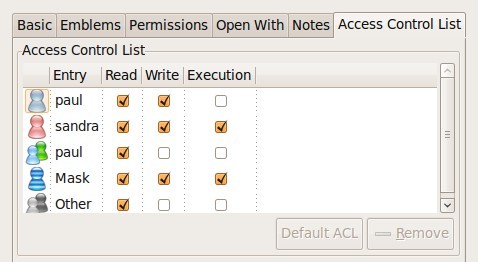Table of Contents
Standard Unix permissions might not be enough for some organisations. This chapter introduces access control lists or acl's to further protect files and directories.
File systems that support access control lists, or acls, have to be mounted with the acl option listed in /etc/fstab. In the example below, you can see that the root file system has acl support, whereas /home/data does not.
root@laika:~# tail -4 /etc/fstab /dev/sda1 / ext3 acl,relatime 0 1 /dev/sdb2 /home/data auto noacl,defaults 0 0 pasha:/home/r /home/pasha nfs defaults 0 0 wolf:/srv/data /home/wolf nfs defaults 0 0
Reading acls can be done with /usr/bin/getfacl. This screenshot shows how to read the acl of file33 with getfacl.
paul@laika:~/test$ getfacl file33 # file: file33 # owner: paul # group: paul user::rw- group::r-- mask::rwx other::r--
Writing or changing acls can be done with /usr/bin/setfacl. These screenshots show how to change the acl of file33 with setfacl.
First we add user sandra with octal permission 7 to the acl.
paul@laika:~/test$ setfacl -m u:sandra:7 file33
Then we add the group tennis with octal permission 6 to the acl of the same file.
paul@laika:~/test$ setfacl -m g:tennis:6 file33
The result is visible with getfacl.
paul@laika:~/test$ getfacl file33 # file: file33 # owner: paul # group: paul user::rw- user:sandra:rwx group::r-- group:tennis:rw- mask::rwx other::r--
The -x option of the setfacl command will remove an acl entry from the targeted file.
paul@laika:~/test$ setfacl -m u:sandra:7 file33 paul@laika:~/test$ getfacl file33 | grep sandra user:sandra:rwx paul@laika:~/test$ setfacl -x sandra file33 paul@laika:~/test$ getfacl file33 | grep sandra
Note that omitting the u or g when defining the acl for an account will default it to a user account.
The -b option of the setfacl command will remove the acl from the targeted file.
paul@laika:~/test$ setfacl -b file33 paul@laika:~/test$ getfacl file33 # file: file33 # owner: paul # group: paul user::rw- group::r-- other::r--
The acl mask defines the maximum effective permissions for any entry in the acl. This mask is calculated every time you execute the setfacl or chmod commands.
You can prevent the calculation by using the --no-mask switch.
paul@laika:~/test$ setfacl --no-mask -m u:sandra:7 file33 paul@laika:~/test$ getfacl file33 # file: file33 # owner: paul # group: paul user::rw- user:sandra:rwx #effective:rw- group::r-- mask::rw- other::r--
